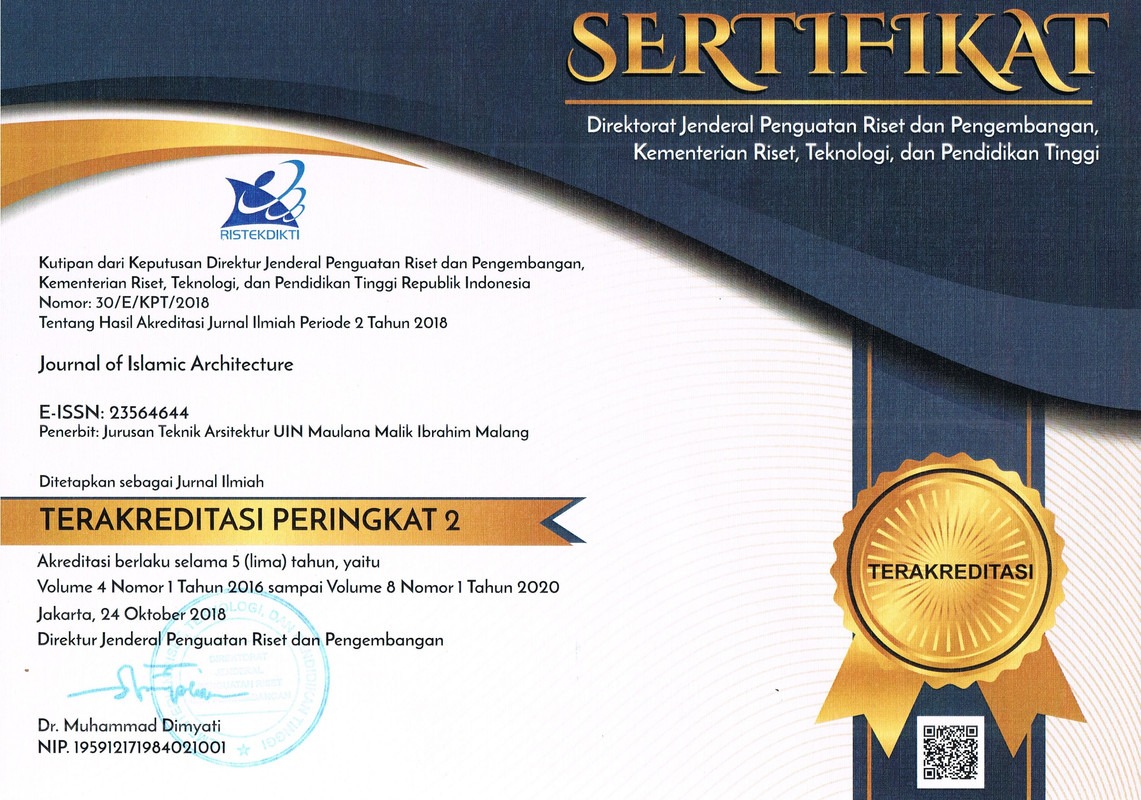The Ecology Character Of Banda Aceh City In The 17th Century
Abstract
Bandar Aceh Darussalam as tamaddun city in the tip of Sumatera Island and capital city of 17th century Islamic Aceh Sultanate, was a strategic coastal city. It had sloping beach and bays and was surrounded by mountains with rivers flowing through the city. Its wetlands-based urban development was reflected in the design of urban space structure and key elements of the city. It becomes inspiration for developing modern ecological city since 17th century Islamic cities in archipelago of the East is rarely studied. This research aimed to study the spatial concept of Bandar Aceh Darussalam. Data was collected by using the method of tracking physical information through ancient maps and field observation of the environment characteristic. It was found that the ecological character of the city seemed to be affected by the existence of integrated natural features, function and the role of the city that included Islamic concepts. The main elements of the city reflected the character of civilization in three aspects: the drainage system i.e. cut and fill, the scattered and wide empty space, and natural defense system. The concept of harmony between urban development and city’s ecological character was shown in the design of urban landscape.
Keywords
Full Text:
PDFReferences
D. . Williams, Sustainable Design: Ecology, Architecture and Planning. USA: John Wiley & Sons, 2007.
R. Forman, Urban Regions: Ecology and Planning Beyond The City. New York: Cambridge University Press, 2008.
C. A. Doxiadis, Ekistics An Introduction to The Science of Human Settlements. Oxford: Oxford University press, 1968.
S. Eisner and A. Gallion, The Urban Pattern. 6th ed. New York: Van Nostrand Reinhold, 1986.
S. Kostof, The City Shaped: Urban Pattern and Meanings Through History. London: A Bulfinch Press Book, 1991.
J. Colding, “Ecological Land-Use Complementation’ for Building Resilience in Urban Ecosystem,” Landsc. Urban Plan., vol. 81, pp. 46–55, 2007.
A. R. Farhan and S. Lim, “Resilience Assessment in Coastline Changes and Urban Settlements: A case study in Seribu Islands, Indonesia,” Ocean Coast. Manag., vol. 54, pp. 391–400, 2011.
A. Newton and J. Icely, “Land Ocean Interactions in the Coastal Zone, LOICZ: Lessons from Banda Aceh, Atlantis, and Canute,” Estuar. Coast. Shelf Sci., vol. 77, pp. 181–184, 2008.
F. Numberi, Perubahan Iklim: Implementasi Terhadap Kehidupan di Laut, Pesisir dan Pulau-pulau Kecil. Jakarta: Fortuna, 2009.
A. Reid, Asia Tenggara Dalam Kurun Niaga 1450-1680, Jilid 2: Jaringan Perdagangan Global. Jakarta: Yayasan Pustaka Obor Indonesia, 2011.
O. A. Hoesin, Kultur Islam : Sejarah Perkembangan Kebudayaan Islam dan Pengaruhnya dalam Dunia Internasional. Jakarta: Bina, 1981.
I. Adrisijanti, Arkeologi Perkotaan Mataram Islam. Yogyakarta: Penerbit Jendela, 2000.
B. Wiryomartono, Seni Bangunan dan Seni Binakota di Indonesia. Jakarta: PT Gramedia Pustaka Utama, 1985.
K. A. Arif, D. Muhammad, and E. Endarmoko, Ragam Citra Kota Banda Aceh: Interpretasi Sejarah, Memori Kolektif Dan Arketipe Arsitekturnya. Bandung; Banda Aceh: Pustaka Bustanussalatin; BRR NAD-NIAS, 2008.
D. Lombard, Kerajaan Aceh Zaman Sultas Iskandar Muda (1607-1636)., Terjemahan. Jakarta: KPG Forum Jakarta-Paris; Ecole Francaise d’Extreme-Orient, 2006.
L. Groat and D. Wang, Architectural Research Methods. New Jersey: John Wiley & Sons, 2013.
T. Kuleli, A. Guneroglu, F. Karsli, and M. Dihkan, “Automatic Detection Of Shoreline On Coastal Ramsar Wetlands Of Turkey,” Ocean Eng., vol. 38, no. 10, pp. 1141–1149, 2011.
M. Alberti, D. Booth, K. Hill, B. Coburna, C. Avoliob, and S. Coed, “The Impact of Urban Patterns on Aquatic ecosystems: An empirical analysis in Puget lowland sub-basins,” Landsc. Urban Plan., vol. 80, pp. 345–361, 2006.
M. Umitsu, C. Tanavud, and B. Patanakanog, “Effects of Landforms on Tsunami Flow in the Plains of Banda Aceh, Indonesia, and Nam Khem, Thailand,” Mar. Geol., vol. 242, no. 1–3, pp. 141–153, 2007.
J. Ehrenfeld, “Evaluating Wetlands Within An Urban Context,” Ecol. Eng., vol. 15, pp. 253–265, 2000.
R. May, “Connectivity in Urban Rivers: Conflict and Convergence Between Ecology and Design,” Technol. Soc., vol. 28, no. 4, pp. 477–488, 2006.
J. R. Curray, “Tectonics and History of the Andaman Sea Region,” J. Asian Earth Sci., vol. 25, no. 1, pp. 187–232, 2005.
E. Meilianda, “Past, Present and Future Morphological development of A Tsunami-Affected Coast, A case Study of Banda Aceh.,” University of Twente, Netherlands, 2009.
M. Craghan, “Sediment Delivery and Accumulation in a Developed Area During Coastal Floods,” Geomorphology, vol. 69, no. 1–4, pp. 57–75, 2005.
L. Airoldi, A. Marco, M. W. Beck, S. J. Hawkins, P. R. Jonsson, and D. Martin, “An Ecological Perspective on the Deployment and Design of Low-crested and Other Hard Coastal Defence Structures,” Coast. Eng., vol. 52, no. 10–11, pp. 1073–1087, 2005.
A. Reid, Menuju Sejarah Sumatera: Antara Indonesia dan Dunia. Jakarta: Yayasan Pustaka Obor Indonesia; KITLV, 2012.
F. . Siauw, Muhammad Al-Fatih 1453. Jakarta: Alfatih Press, 2013.
A. Hadi, Aceh: Sejarah, Budaya dan Tradisi. Jakarta: Yayasan Pustaka Obor Indonesia, 2010.
A. B. Gallion and S. Eisner, The Urban Pattern. USA: Van Nostrand Reinhold, 1986.
M. Freeman and C. Jacques, Ancient Angkor (Books Guide). Thailand: Amarin, 2012.
D. Noor, Geologi Lingkungan. Yogyakarta: Graha Ilmu, 2006.
DOI: https://doi.org/10.18860/jia.v4i3.3872
Refbacks
- There are currently no refbacks.






